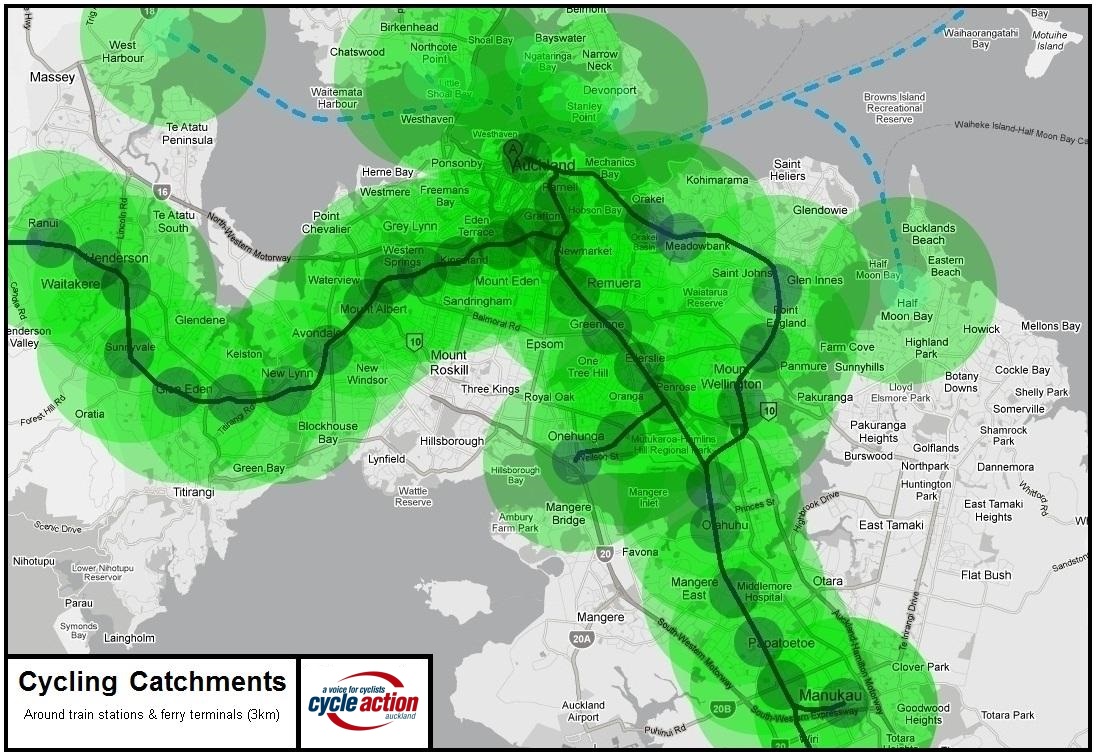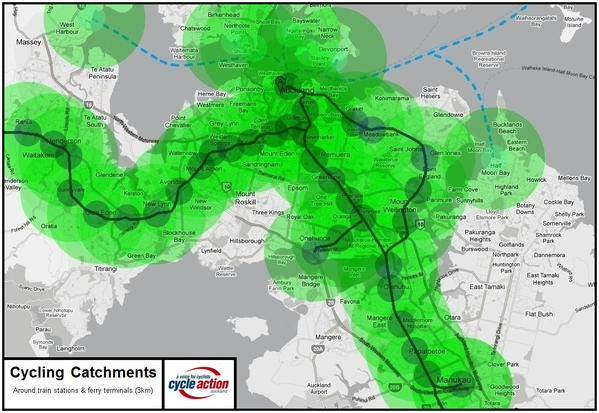Following on from our posts on cycle streets and cycle boulevards, this post will look at how this cycling infrastructure can increase the catchment areas of public transport.
It is generally accepted that the maximum acceptable walking distance for public transport like trains and ferries – or a busway – is around 800m. Ideally it should be less than this and the tram system that operated in Auckland until 1955 aimed for a 400m maximum walking distance, by the use of smaller blocks and spacing of the stops.
Using an 800m catchment area, we see the public transport catchment area around the existing train network and ferry terminals as something like this:
As you can see this gives a fairly good catchment but there are large white areas where walking to trains and ferries would be beyond the distance most commuters are happy with. This is because time is probably THE main consideration for commuters and it will take the average person around 10mins to walk 800m at a reasonably brisk walking speed of 5-6km/h, allowing for the occasional delay such as crossing roads. Beyond such distances, the walk becomes too long for most, in more than one sense. [Although with increasing residential densities around transit hubs in the future, even at walking pace a sizeable percentage of Auckland will be close enough to the 10-minute frequencies the electric trains will give us, and the even more frequent services after the completion of the CRL].
As most of you are aware, one of the biggest uses of bicycles in cycle friendly countries like Netherlands and Denmark of bicycles is to travel from home to the local public transport station. Around 40% of train passengers in the Netherlands use bicycles to reach the train station and another third walk to the station.
This is made possible by the fact 45% of Dutch people live within 3kms of a train station, with great cycle conditions – and you can see it by the legendary cycle parking facilities at train stations:
![[Is that a tree growing through the middle?]](https://www.bikeauckland.org.nz/wp-content/uploads/2013/11/Bike-Parking-Tree.jpg)
Overcrowded cycle facilities are actually becoming a problem in the Netherlands – though it’s a problem the Dutch are very happy to have as it is far cheaper to solve than Auckland’s transport issues. The Netherlands spends around 30 Euros a year per person on cycling facilities, about $50 NZ.
[Editor’s note: Depending on what you include, a rough estimate for NZ’s own spending on cycling currently might be around $7-14 per person per year, despite a much worse backlog than the Dutch have.].
Over 70% of cycle trips in the Netherlands are less than 7.5kms. In Auckland, the Auckland Regional Transport Authority (ARTA) estimated in 2007 that approximately 43% of peak morning trips are less than 5 km, and that approximately 67% of these are currently undertaken by car (ARTA 2007). The Ministry of Transport, Household Travel Survey, 2003–2009 revealed that one-sixth of household car trips in New Zealand were less than 2km long and almost half were less than 6km long. So it appears that our travel patterns are not that much different than in the Netherlands – only our choice of mode.
If we keep our 10min acceptable travel time for commuters to travel to high-quality public transport, we can calculate that most commuters should be happy to travel up to 3kms by bicycle at an average speed of 20km/h. This is a very comfortable travel speed and doesn’t require a huge amount of physical effort, no more than walking for the same period of time. If you have an electric bike, it is even easier! The 3km cycle range has also been found to be a suitable range by NZTA research.
A catchment area of 3kms gives us the following catchment map for train stations and ferry terminals:
As you can see, residents of almost the entire central isthmus, most of West Auckland and large parts of South Auckland are within a 10min cycle ride from a train station. In addition, almost the entire Devonport peninsula, Northcote, Birkenhead and the Howick area are within a 10min cycle ride of a ferry terminal.
Unfortunately this map doesn’t show western and far southern Auckland, nor the scope of the Northern Busway stations – or the future AMETI busways to the east – but you get the idea!
I know many people list hills as a major consideration as to why cycling won’t work in Auckland. I suggest this is mainly because cycling has been presented as a commuting option to your place of employment, which is often a distance of more than 5kms and may often include at least one major hill. However, despite Auckland’s hilly topography, there are many people who would have a fairly flat ride if the distance was less than 3kms (or you might chose to go to a train station that is 3km away, but has a flat ride, instead of the closer one that needs you to go up a hill).
In order to make this a viable option for a significant percentage of Aucklanders, there will of course need to be adequate infrastructure in place to make cyclists feel safe. The fact that cycling in Auckland is in fact already statistically safer than driving on a per hour basis is irrelevant – we must have infrastructure in place that FEELS safe, that allows children, women and the elderly to cycle, not just the 1-2% of Aucklanders who currently ride and who are largely males between 25 and 40 years of age. In fact, one of the biggest indicators of a safe cycling environment is the percentage of female cyclists. For example, 55% of Dutch cyclists are women. In NZ it is more like 15-20%.
Most Aucklanders have some anecdotal evidence of why it is impossible for them to cycle to their local transport option. But two things need to be considered. First, what would it take for that situation to change? Do people need better cycle infrastructure, or is there something inherent in their job (tradie, travelling salesperson) that requires them to use a car? If the problem is their job, what percentage of people they know have the same issue?
Second, it is well known that traffic in Auckland improves significantly during school holidays, often dramatically. This situation is attributable to a 5% drop in traffic volumes, an amazingly low percentage. If only a small number of commuters were to cycle to public transport, that would create huge knock on benefits for all motorists.
The real change needed for a network of cycle streets would be ensuring lower travel speeds of 30-35km/h on residential streets. Remember this would not apply to arterial roads, only to the quiet residential streets that usually make up 5-10% of most driver’s travel distances. That seems to me to be a small sacrifice to create a safer and more pleasant street environment for us all. So the benefits of offering this option to even a small minority of Auckland’s population will create benefits that can be enjoyed by everyone:
- More cycling – creating a virtuous cycle increasing safety, public acceptance and funding
- More public transport use – using our investment more efficiently, and creating a real mixed-transport city
- Decongesting existing roads for those who still want or need to drive, easing the constant pressure for “more roads!”
- Creating more liveable and safer suburbs for our communities
The costs of putting in place cycle boulevards and cycle streets are incredibly low. The amount spent on consultant reports for one Road of Dubious Significance would pay for a large network of such facilities in Auckland. The cost of separated cycle infrastructure on arterials is greater but will also happen alongside this, if the cycling numbers and modal share can be increased.
So let us go for this, big time – if this isn’t seen as low-hanging fruit, it’s only because we still need to open our eyes!




